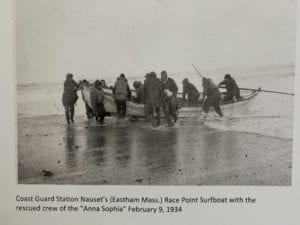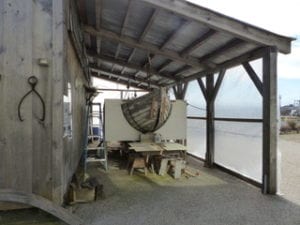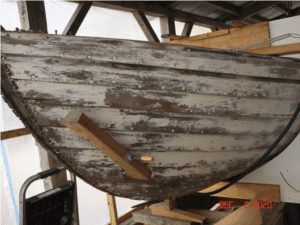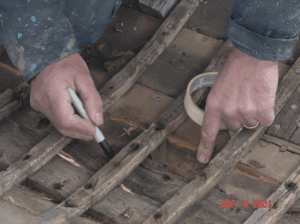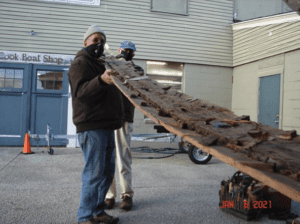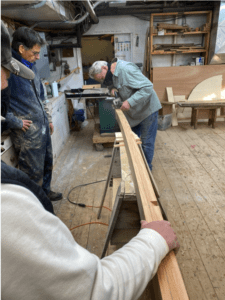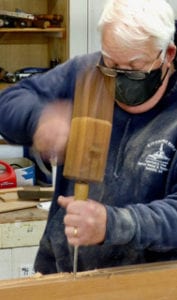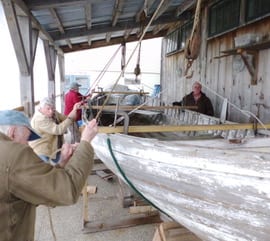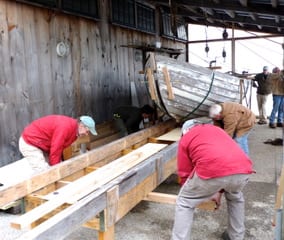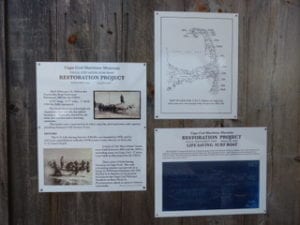A Surf Boat Restoration on Cape Cod
Many of us who live on Cape Cod are here because we love the beach. In particular, the beaches facing the Atlantic Ocean in the towns of Chatham, Orleans, Eastham, Wellfleet, Truro and Provincetown. We walk the beaches to reflect on our day or the past year. A meditation unfolds with each stride in the silky sand. We listen to the wind, or the still air. We listen to the many different species of birds and the breaking waves. There is always a symphony of sounds making the time alone special. You leave longing for your next beach walk.
Imagine, while on your next walk, it’s February 9th, 1934. You are enlisted with the U.S. Coast Guard and stationed at the Nauset Station in Eastham. Around mid-day, the Coast Guardsman on watch calls for all hands-on deck to head out to rescue the crew aboard the two masted Schooner Anna Sophia. The surfmen work fast to haul their Race Point surfboat to the
water’s edge and, as practiced weekly, push her into the heavy surf and the freezing cold February wind. The two bowmen climb aboard, holding the bow steady, followed by the remaining three mid-ship rowers. When they are confident the wave break is timed perfectly, the last push comes from the skipper who is also the coxswain he jumps aboard. The coxswain steers the boat with his 20’ oar, in the 24‘6”, 1200-lb, cypress-on-oak, clinker-built, Race Point surfboat toward the Schooner. Each man pulls the 12’ oars in unison toward the stranded crew. As her 6‘2” beam and 2’ draft slices through the water, up and over the waves, cold water sprays all over the men protected by their oil skin gear.
In this particular rescue, they saved all five aboard the Anna Sophia, including the Schooners dog, but sometimes, that was not always the case. The extreme weather off the shores of Cape Cod often created difficult conditions for the surf men to approach vessels that had run aground while working their way North or South to deliver supplies to the East Coast cities.
Coast Guard historian, *Richard Boonisar compares the coastal shipping lanes of the 19th and 20th century to the well traveled Interstate 95 today. “It was the best way to move large amounts of goods up and down the coast”. And sadly, over these years between 1877 and 1914, 27 Cape Cod keepers and Surfmen died in the line of duty; 11 by drowning. There are over 400 wrecks off Cape Cod and 220 surfboat men were lost, while on duty from
the Jersey shores to Cape Cod. Some surfmen died from rescue attempts, some from sickness, as a result of a rescue.
The first Race Point surfboat was designed by *George Bickers of the Race Point Life-Saving Station and built by Charles Gardner of Provincetown, hence the name dating back to 1894, by which the boats were called. This simple design, the choice of construction scantlings made her light and strong. Her full bow and high freeboard are all features that evolved over the years and lead this to be the best design for five rowers and a coxswain, to move her efficiently into the surf and leave enough room for the rescued. So, began the long history of the surfboat.
A total of 143 wooden Race Point surfboats were built by private yards on and off Cape Cod, all were built without a set of proper builder plans. In 1922, a set of plans were finally drawn up by Ralph Winslow of Quincy, Massachusetts. Now, with proper plans in place, 57 more surfboats could be built at the Curtis Bay Coast Guard Yard in Maryland. At the end of World War II, 59 were still in service along the East Coast. Some of the Cape Cod stations like the Cahoon Hollow station, had two boats ready to go. The end of World War II ended the use of pulling surfboats>they were replaced by motorized vessels, like the CG 36500 Lifeboat made famous in the movie The Finest Hours.
One of the 57 Curtis Bay surfboats, boat #24467 constructed in 1944 retired from duty and became property of the National Seashore on the outer Cape sometime after World War II. She
was on display at the Eastham headquarters until she was moved to a storage location. She did not have a long history on duty but she represented the boats that did.
In the early 2000s, the Seashore management team realized that boat #24467 was going to rot away if someone did not take an interest in her. So, calls were made, and she was transported to the Cape Cod Maritime Museum on South Street in Hyannis. She was in poor condition and was stored outside, due to a lack of space at the museum. Around this same time in 2005, Richard Boonisar exhibited his restored Race Point surfboat at the museum for their Life-Saving Exhibit. After the success of this exhibit, Trustees of the Cape Cod Maritime Museum began to consider restoring the Curtis Bay surfboat, which was deteriorating further with each passing winter. She was getting beyond the point considering restoration. The museum had an opening in the shop for a project and weighing the fact that the cost in materials for a complete re-build was reasonable and the work would be done by volunteers, it was voted after some debate, to give it a shot. A restoration is historically a more profound way to preserve the work of past shipwrights and a vessel with a notable history.
In 2018, plans were put in motion to acquire ownership of surfboat #24467, from the U.S. government and restore her to her full glory at the Museum’s Cook Boat Shop. She would join the fleet of three currently restored Surf boats on Cape Cod.
Working as a volunteer group, Bill Stirling, Alan Reed, Bob Lister, Ray Ward, Richard Boonisar, and I are working once a week to bring her back to life. As the project progresses, many of the other Museum’s boat shop volunteers will help prepare her for the water.
While planning the restoration, we brainstormed how we could secure the very fragile hull. We needed her to be shored up in a fashion that would allow us to fit a new keel, stem and stern post without losing any more shape. We needed to engineer a plan to remove the hog in the bow and keel and get the hull tweaked and gently pushed back to her original lines.
In February of 2019, at an after party (hosted by the Maritime Museum) for boatbuilders and exhibitors attending the Cape Cod Boat Builder’s Show, Don Chapin, of Chapin Custom Boats, had the idea to build mold stations that represented the outside of the hull. We had plans and offsets thanks to *Richard Boonisar, so Don entered the offsets into his CNC machine and cut out the molds for us. This allowed us to twist and push the boat into her original shape and secure her to the shop floor on a ladder frame that Don loaned us. She was now set up similar to a new boat construction; right side up. The big difference the molds, represented the outside planking. Now we had an open area in the boat to work. In 2021 we will install a new keel, stem, stern, and frames — and eventually planking, inwales, gunwales and thwarts.
As we learn more about the history and lives saved by the Race Point surfboats, this restoration project has become a great attraction to share with museum visitors. So, the next time you are walking on the ocean-facing beaches of Cape Cod, be reminded of what *Richard Boonisar said in the closing of a recent interview /podcast at Capecodmaritimemusuem.org : “Put on some 1900’s oil skin gear and walk straight into a Nor’easter in February. Look at the sea state, feel the snow and sand in your face and then imagine pushing a 24’ lifeboat into the waves, to save lives, knowing you may not return.”
This project will take a couple of years to complete based on the schedule we have set up. Please keep an eye on the Cape Cod Maritime Museum website https://www.capecodmaritimemuseum.org/surfboat-restoration for updates on our progress. If you would like to donate to help this effort, there is a link to donate on the site. If you have any experience with Race Point surfboats or would like to share any history, please feel free to get in touch via email. We would love to hear from you.
– Tony Davis
Arey’s Pond Boat Yard Owner, CCMM Trustee and Volunteer
* Credit for the historical records.
* Richard Boonisar Owner of the Gurnet Point Coast Guard Station Plymouth Mass and Coast Guard Historian.
* American Coastal Rescue Craft B William D Wilkinson *Commander Timothy R.Ding

